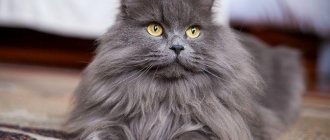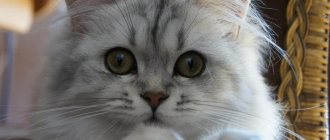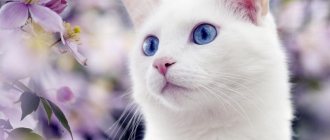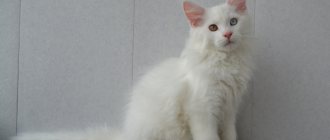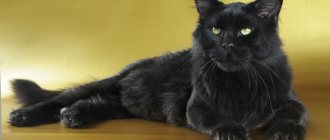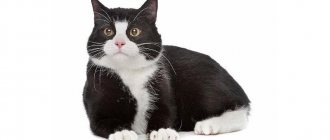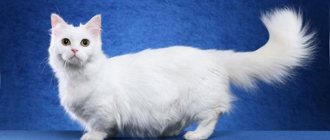Gray cats have long been considered the guardians of peace and prosperity in the home; they are said to also help their owners gain financial well-being. But gray cats protect from troubles like human envy and unwanted guests. Surely such beliefs can be applied to Maine Coons - massive cats with luxurious long hair and a thoughtful look. One has only to glance at the photo of a gray Maine Coon and one can understand how much nobility there is in this representative of the cat family.
Maine Coon and its specifics
Representatives of the breed stand out among other domestic cats primarily due to their large size. Moreover, this is a rare case when appearances turn out to be deceiving. Animals are famous for their gentle nature and playfulness. The animal will quickly find a common language with older children and become their faithful friend.
The main character traits of the Maine Coon are:
- intelligence;
- affectionateness;
- energy;
- calmness.
The breed, by and large, has only one drawback. A Maine Coon will not be able to get along in a house where, besides itself, there are also other, small pets such as hamsters, rats, etc. Instincts will prevail, and other “tenants” will become the object of hunting.
Maine Coons are gray and not very
From the point of view of felinology, the gray Maine Coon is an individual of blue color, whose fur is colored a rich gray-ash color with a bluish tint. This cat coloring is very popular in the USA (the homeland of Maine Coons) and a number of other European countries. In Russia, you won’t find a blue Maine Coon in every nursery. By the way, gray Maine Coons, or rather blue ones, appeared as a result of lightening the black color, that is, initially there was no such color at all, it was bred during the work of breeders.
What affects the price of a Maine Coon
It is difficult to answer definitively how much a cat costs. It all depends on his status. There are three main categories into which all purebred animals are divided. We are talking about the following classes:
- show;
- breed;
- Pat.
Maine Coons, classified in the first group, are the most expensive. How much do they cost? You will have to pay an average of 100,000 rubles for a kitten. Such a high price is explained by the following - the animal fully meets the requirements of the breed standard. Him:
- impeccable pedigree;
- perfect health;
- perfect exterior.
Such a cat will be able to participate in international exhibitions and breeding. Typically, the animals mentioned are bought by breeders and fanciers who are not burdened with financial problems.
How to take care of your Maine Coon's gray coat?
There is no doubt that the fluffy and thick fur of Maine Coons is one of their decorations. To ensure that your animal’s hair does not lose its shine, you should remember the following:
- For health in general and an attractive coat in particular, Maine Coons need proper nutrition. Dry or canned ready-made food labeled “for Maine Coons” (or “for large cats”) of super-premium quality (or holistic) is suitable as a diet. As an alternative to store-bought food, natural food is often chosen, which includes lean meat, cereals, vegetables (greens and fruits, if the cat likes them), and sour milk products. If the animal eats the food that the owner prepares for it, you will have to think about fortification. A lack of vitamins E and B always contributes to the deterioration of the coat;
- Almost any disease makes a luxurious fur coat faded and ugly. Stress, invasive diseases, poisoning, skin diseases are just some of the reasons why the fur looks untidy. To understand that an animal is unhealthy, sometimes it is enough to look at its fur;
- Maine Coons are naturally clean cats, so you shouldn’t bathe them often. As a rule, bath procedures are carried out once every 3-6 months using a special shampoo for long-haired cats, after which the pets are dried with towels and a hairdryer. Show cats are bathed more often, before each appearance. In this case, not only cleansing shampoo is used, but also coloring, degreasing and texturizing grooming products;
- Domestic gray Maine Coons are brushed two to three times a week, and daily during shedding. For the fur on the body, brushes with long teeth are used, for the face and limbs - with short ones. Sometimes they do it differently: first they comb the cat with a brush with sparse teeth, and then with frequent ones. It’s hardly worth neglecting combing, because thick fur will quickly form tangles that will simply have to be cut out, depriving the animal of hair growth;
- During shedding, gray Maine Coons lose hair no less than other long-haired cats. Typically, the fur begins to shed twice a year, usually in early spring and late summer or fall. If the air in the room is too dry, shedding may be prolonged. To prevent the animal from swallowing hair during active hair loss, it makes sense not to neglect combing. And if necessary, you can give the cat a special product - a paste or gel for removing hairballs;
- Sometimes handsome Maine Coons are taken to a grooming salon for a haircut (usually the hair on the body is shortened). On the one hand, after a haircut, it is easier for an animal to survive the heat (especially if there are no cooling devices in the apartment). And the owner has less worries in the form of lengthy combing. However, almost all owners who have carried out a similar procedure at least once note that the new coat that grows is of poorer quality: thinner and more prone to tangling. It turns out that it is better to remove dead hairs with a regular brush, without depriving the Maine Coon of his thick and beautiful coat.
What else does the cost depend on?
Maine Coon kittens are most expensive when they are no more than 4 months old. During this period, the baby is already able to do without his mother and is ready to get acquainted with the world around him.
The animal receives its first vaccinations and can endure the journey and adapt to new conditions. Kittens have not yet acquired bad habits, and therefore are easy to learn.
After five months, representatives of the Maine Coon breed become sharply cheaper, because the cat already has time to develop to a certain extent as a personality. Consequently, its owner will have to spend more effort and time on raising it.
Also, the difference in price depends on gender. In particular, cats always cost more. The nuance is that males are much larger and more sociable. Accordingly, there is greater demand for them. Cats are smaller and more active and independent. All this makes the maintenance relatively troublesome, and this, in turn, is not always suitable for potential owners.
The price of a Maine Coon is also influenced in a certain way by its color. Purebred animals whose coat color is non-standard are sold very expensively. Everything here is quite subjective and depends on current fashion trends.
Color options for gray Maine Coons
Solid blue
– according to the rules of the breed Standard, this is an animal with a gray coat that does not have a pattern. However, if you look at a photo of a gray Maine Coon, you can almost always find at least faint stripes, stains, and spots. All this is due to the tabby gene, which is responsible for the pattern present on the Maine Coon coat. But sometimes (albeit very rarely) true solids are found - those whose coat is evenly colored in a single solid color. In some cases, white spots may be present on a gray coat, which is undesirable;
Blue tabby
– cats with a similar color have a clearly defined pattern on the fur: head, chest, torso, limbs and tail (sometimes with white markings). Maine Coons have only three tabby variants:
- Classic or marbled
- if they talk about an animal whose color is blue marbled (blue marble), this means that there is a pattern on the body that repeats the veins that are found on real rock (marble); - Tiger
- the head, body, paws and tail of the cat are decorated with stripes similar to those found in the color of a real tiger; - Spotted
- the body of the Maine Coon is decorated with numerous darkened spots and stripes (including intermittent ones).
Blue smoky
– a similar color (also called gray smoke) is present in Maine Coons, whose hairs are snow-white at the base, but blue at the tips. It is rare because a color without patterns on the body can be called truly smoky. The color is called smoky only when the hair at the base is white, not light gray. When walking, when the breeze develops the hair of a blue smoky Maine Coon, it seems as if the hairs change color from dark to light gray. Depending on the degree to which the hairs of the coat are colored gray, smoky colors are divided into the following varieties:
- Chinchilla
– hairs are 1/8 gray (blue); - Standard
– hairs are half white, half blue; - Shaded
- Maine Coon fur is a quarter gray, while the rest is white; - Blue silver
- this color means that the tabby pattern is clearly visible against the background of the white-blue smoky coat. Let us remember that gray (i.e. blue) Maine Coons almost always have a pattern on their body. Therefore, the color of patterned animals whose fur is both blue and white should be called blue silver marble (or blue marble on silver), blue silver brindle or blue silver spotted, depending on the type of pattern that is present in the cat. Silver pets, like cats of other colors, may have white markings on their bodies;
Blue and white
- so colored pets can be called gray-white or white-blue in another way. Depending on the location and size of the white spots on the coat, these colors are divided into the following types:
- Bicolor
– blue and white wool in equal parts; - Harlequin
- the fur on the body is white, but there are several blue markings; - Van
- only the head and tail areas are colored blue; - Medallion
– there is a white spot on the neck of a gray Maine Coon; - White buttons
- there are several small white marks against the gray background; - White gloves
– white fur on the cat’s paws; - Tuxedo
- the fur on the whole body is blue, and on the chest and paws it is white.
Where can I buy
Knowing how much they are asking for a Maine Coon now is not enough.
You need to understand where you should buy a kitten, and which offers you should refuse. It is also important to have a good understanding of the characteristics of the breed, current standards, etc. There are known cases when cunning swindlers sold simple kittens under the guise of Maine Coons. The deception is usually revealed only after the animal has matured.
To avoid becoming a victim of scammers, the purchase should be made in a trusted nursery that specializes only in the breed in question. Here, along with the kitten, they also issue documents confirming both the transaction itself and the purity of the animal.
Buying an animal through an advertisement is a riskier undertaking, but in this case it is usually possible to save a very hefty amount. When choosing this method, you need to find out more about the seller. The ideal option is to search through friends and acquaintances. Be sure to demand to see the parents of the proposed kitten - it must at least resemble them (at least like its mother).
There is a big risk of acquiring a defective animal by making a deal with the owners of a conveyor nursery. There are also many of these now. Here cats are kept only for the sake of breeding - they are fed poorly and are practically not looked after. As a result, babies turn out weak and sickly. Such organizations usually sell young animals that are not yet three months old. Animals are often not even vaccinated.
Features and color variations
Objectively, white color in Maine Coons (and all other cats) is not a color. It is expressed by the absence of the coloring pigment eumelanin (black) or pheomelanin (red) and therefore purely symbolically performs the function of characterizing color.
The genetic process begins at the stage of early embryonic development and proceeds as follows:
- Pigment cells take on an elongated ellipsoidal shape and migrate to the area of the developing dermal layer of the skin.
- The centers of pigmentation in cats are located on the head, neck, along the line of the spine and at the base of the tail.
- The cells penetrate the follicles (hair follicles) before they form. Only then do they become melanocytes, which produce coloring pigment.
But all of the above works only in one case - if there is no dominant W gene in the cat’s chromosome map. It suppresses the entire algorithm and then the Maine Coon’s fur remains white, uncolored. And white cats should not be confused with albinos - the nature of the colors is different, as are the genes responsible for such anomalies.
It happens that a snow-white Maine Coon cat has 1-2 colored spots appear somewhere on its fur coat - evidence that we are talking about white spotting. It can manifest itself in extreme forms, when large areas of white color overlap areas of black and red pigments.
Read all about Maine Coon colors in this article.
Combinations of S and W alleles are responsible for this.
- not white – ww;
- bicolor –Ss.
The entire design of color combinations in cats with white coat color rests on these two genes.
- Buttons scattered randomly all over the body.
- White markings in the form of medallions (small spot on the chest), gloves (end of the paws) or tuxedo (chest, legs, head).
- Colored spots on the back and head (“magpie” color).
The main classification of white Maine Coons takes into account the percentage of white and any other color.
- Bicolor – the main color takes up up to 50%.
- Particolor - the proportion of white reaches 90%.
- Harlequin - over 90%.
- Van color of white Maine Coon cats - markings of a different color are present only on the tail and head in the area of the ears.
In bicolor, as a rule, there is an additional ornament on the fur coat. The Maine Coon with a brindle coat and white spots is much more common than its pure white coated counterpart. In the ash coloring, the brindle has a marbled appearance, which gives its name to the separate group.
There is another gradation in the distribution of white color in Maine Coons. It can be expressed in formulas of genes and alleles, but most often practical observations are used.
- The white gene suppresses all others.
- A white Maine Coon kitten must have an equally white parent. Color cannot appear only in the grandfather and grandson. The father is obliged to take his place in this hereditary chain.
- The same rule exists for the color of the undercoat - it is inherited as a direct trait.
- The calico (tortoiseshell and white) combination is dominant over the blue and cream tortoiseshell.
- Variegated (piebald) colors of white are always ahead of solid colors. The same rule applies in the case of white spotting, which prevents the formation of a pure color.
Important! Maine Coons with a perfect white coat do not have brindle stripes. The dominant W gene suppresses the action of all other participants in the genetic process and discolors the fur over the entire surface of the cat’s body.
Maine Coon coat care
Many may mistakenly believe that white wool is very expensive and requires some additional physical and financial costs. However, in the case of a Maine Coon, there is nothing to worry about.
© shutterstock
The wool cleans itself, and dirt does not eat into the hair. It is enough to use simple care, like for any cat.
What do we have to do:
- Brush weekly.
- Bath as needed.
- Do not feed foods that may impart an undesirable tint. On this point, it is best to consult additionally with the breeder and veterinarian.
In addition, I would like to note that Maine Coons’ hair does not get tangled or tangled. Therefore, you don't have to worry that combing will be some kind of complicated process.
